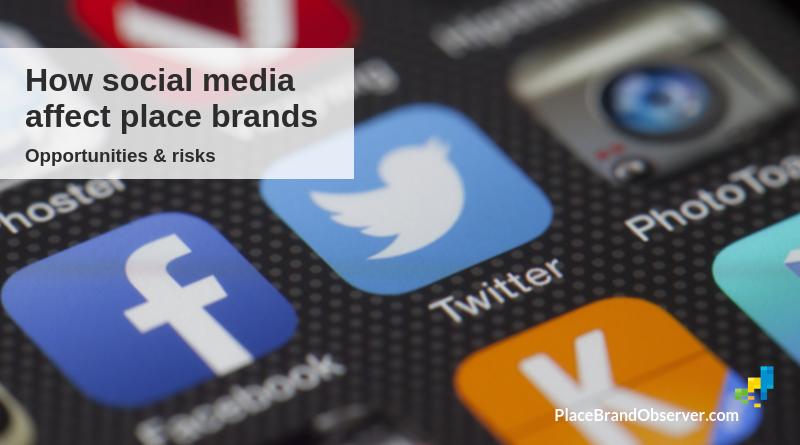How do social media affect the brand of a country, city or destination? Most of us use Twitter, Instagram, Facebook & co. but not always is it clear what impact such postings have on perceptions of places.
Below the answers of our panel of place branding specialists (in alphabetical order – highlighted respondents are available for consulting, research or as speakers).
A few key takeaways:
- Social media today have enormous power.
- They are a great storytelling opportunity for places and brands.
- They are equally dangerous and potentially risky, for places and their image, as misinformation can spread fast and wide.
- Since place branders have much less control now over the image and identity presented of a place, we must try to manage, influence and interact with what is posted online.
- Social media postings from individuals and influencers are considered more credible than formal communications.
- In public diplomacy, social media have turned the tables, blurring the lines between professionals and amateurs, senders and receivers, international and domestic affairs.
- Social media are a treasure chest of data, but we don’t really know what to do with it (yet).
And our favorite quote:
For a good brand, based on true substance, social media is the gift that keeps on giving. But, for brands that lack substance and project themselves dishonestly, social media is, rightly, the kiss of death. (Tom Buncle)
Adam Mikolajczyk
It is obvious that social media today have enormous power, they can even disprove dictators and governments of countries. That is why they are very often used as a leading channel of place branding activities.
One of the “byproducts” of good placemaking is to attract visitors to these new public spaces. And because visitors (and residents) more and more share their experiences via social channels (especially Facebook and Instagram), placemaking – with accompaniment of social media – has become a powerful tool for creating and promoting place brands.
 Andrew Hoyne
Andrew Hoyne
Social media has changed the world forever. YouTube and Facebook are now two of the top ten most used Search Engines in the world. We search for everything on socials – from a new place to eat eggs to a new place to travel.
This shift should not be perceived as a negative – we just need to understand how to use social media effectively to bring a brand to life. In fact, when managed strategically social media will result in increased visitors, national pride and media attention as well as a raised cultural profile, more commercial interest and investment.
Country brands should be the ones driving how they are perceived on social media. They need to first identify or create elements which are unique to the country and in line with its place brand, which can be leveraged as social media magnets and embedded across the rest of their marketing.
By enhancing naturally occurring landmarks or creating them from scratch, aspects that appeal to social media can become attractions in their own right and can completely change the fortunes of a place or country. A landmark can be utilised to create interest, set tone, change perceptions, break news, tell stories and attract bodies. Done well, this approach ensures a country and its brand will be perceived as different or unique on and off social media.
Finally, social media enables us to craft extensive visual stories, for instance around the changing seasons of a country. Events like this are a great opportunity to engage a huge audience with the unique idiosyncrasies of a place. These stories will then attract people with varying interests which relate to activities and destinations that come alive during seasonal changes.
 Christopher Hire
Christopher Hire
Social media can dramatically improve a country brand, especially through images of positivity. Social media has more clout than stalwarts like CNN, even though viewers of the latter might have higher budgets than the more democratic social media.
Social media matters.
Ed Burghard
I am certain there are many ways. But, the one way I’d like to draw attention to is the impact of amplifying negative news. Social media is a rapid way of disseminating negative (or even fake) news about a location. Bad news seems to trend quickly on social media platforms. That is why it is critically important to audit your community footprint in social media channels.
Eduardo Oliveira
Developments on the Internet and social media have allowed the acquisition of immeasurable amounts of information, from landscape descriptions to pricing, accommodation ratings and also scandals – all of which influence the image of destinations.
In addition, the Internet and social media are optimal platforms to spread a narrative, a story and a message. The factors including a fresh wave of web-based communities, known as web 2.0 and social media (e.g. Facebook, Twitter, Instagram, YouTube and TripAdvisor), have changed market conditions for Destination Marketing Organizations (DMOs).
Furthermore, social media has become a highly effective way to reach out and engage with the masses. In particular, social media allows a DMO to develop an online voice, which should be consistent with its destination brand. Therefore, a resilient and strategic approach to digital channels should be a corner stone of a strong destination branding strategy.
Gregory Pomerantsev
Social media is a reflection of popular ideas, a tool for their identification and analysis. And, at the same time, a powerful channel of their creation. By choosing the necessary or convenient contexts and formats of publications, SM publishers form in the readers the perception which can differ significantly from the “reference”, from the professional one.
A city may be perceived a boring place with no landmarks or special spirit – and it is quite possible that tomorrow, with the advent of new contexts through social media, it will have a “new face”.
 Heather Skinner
Heather Skinner
There is less control over the identity being presented of a country when considering all the user generated content on social media. The country brand that is being formally communicated must align with what else is being posted over the many social media channels.
People are more likely to believe what other individuals and influencers post about a place, than what is presented to them through formal communications.
José Pablo Arango
Today social networks are the center of conversation in everything, especially the bad or the false. As country branders we must try to lead the conversation.
 Juan Carlos Belloso
Juan Carlos Belloso
Today, social media has a deep impact on perceptions about a place. The only problem with this is that we cannot control social media. What we can do is try to manage it and influence through stories and positive experiences and references from people, using social media.
Marta Herézniak
Social media constitute a narrative about a country that is alternative to traditional media or state propaganda. It functions as a sort of checks and balances mechanism for whatever agenda the governments are setting.
Also, in official country brand communication, social media have turned the tables– especially in public diplomacy. The advent of social media fundamentally transforms the character of diplomatic efforts and requires a new set of competences from diplomats all over the world. It proves to be one of the most powerful political tools available to all sorts of actors, blurring the lines between professionals and amateurs, senders and receivers, international and domestic affairs.
Unfortunately, social media also give voice to multiple fake news, the results of which can be catastrophic for a country brand.
 Martin Boisen
Martin Boisen
For the love of place / Researcher profile
Social media is surely a treasure chest of data, but what that data really means, and what the impact is of social media, is still largely a secret to us.
The one thing I will agree on is that it does have an effect. But what effect and how much? I don’t know.
Oliver Zöllner
Given the fact that such a vast number of people worldwide use social media on a daily basis, posts and tweets have a tremendous potential impact – if they are widely read, shared, etc. The impact may be both positive or negative. It depends on the nature of the contents, of course, and on the communities sharing the messages, and/or publics forming around them.
If an account operated or funded by a country, or a private citizen or non-aligned organisation, manages to get the attention of a wider group of people (and that is not an easy task), it may positively inspire people’s imaginations or it may – negatively speaking – put people off, thereby over time improving or tarnishing the country brand. But this is a complicated and multi-layered process, not easily manageable.
 Pärtel-Peeter Pere
Pärtel-Peeter Pere
The impact of social media on place brands is huge. Recently, Denmark and Sweden got into a Twitter war. This exchange of courtesies generated millions of views.
The Curators of Sweden was a famous and much copied concept.
Witness the great work that #Finland is doing with SoMe. Put simply, #FinlandWorks because it takes things seriously and makes them work, including social media. #TalentBoost is an example when it comes to talent attraction.
Emojis of Finland is one of the best SoMe initiatives we’ve seen. Witness how active, diverse, interesting and contemporary the content which thisisFINLAND puts forward.
#FinnishTingles is absolutely brilliant! This is a series of videos helping to lend a bit of the Finnish calm to the very stressed Swedish youth (as statistics say) by the cunning use of ASMR.
These examples are quirky, innovative and fun to watch. These are “things you should and shouldn’t know” about Finland.
 Robert Govers
Robert Govers
Independent advisor / Speaker / Researcher
Social media provide a tremendous opportunity as they allow for “on-brand” initiatives (imaginative policies, projects, events, investments) to be talked about widely and hence spread the good news organically (which is much more effective and less costly than communicating through advertising).
I refer to this in my book as “action communication, in the sense that reputations are built by what you do and not by what you say about yourself. Actions speak much louder than words”, particularly on social media.
Sonya Hanna
It remains that a country brand is not about logos and slogans but about the communication of an identity embodied in the context of that country, be it its cultural, historical and/or its future aspirations.
Gone are the days when one-way conversations were pervasive. Social media has allowed stakeholders (government organisations, public and private bodies, tourists, investors and residents) to participate in the development of a country’s brand identity.
The operative word here is ‘participate’. While the scale and scope of social media presents a particular, and potentially, ongoing resource challenge, DMOs are not devolved of their powers, they remain capable and should steer and seed country narratives in a way that stimulates positive and consistent place-consumer perceptions.
The challenge, however, is not only to be aware of various social media platforms on which social and formal conversations may appear, but of the communicative goal of these conversations.
To steer/seed country narratives, increased coordination not only needs to occur between government organisations but also between their respective stakeholder organisations, and UGC should be mined to identify and comprehend the root of stakeholder perceptions.
Todd Mayfield
Personally, I don’t get a lot of messaging about country brands on social media, unless it is newsworthy. I think right now, news feeds are the most influential about countries. I’m surprised that there is not more country brand marketing in social media. Maybe there is an opportunity in the making.
 Tom Buncle
Tom Buncle
Social media impacts country brands both positively and negatively.
Positively:
- Reach and impact: social media offers a credible, neutral distribution channel, with massive potential for multiplying brand awareness through third party engagement and sharing – but only if the product/experience is largely positive and credible. This is especially valuable for smaller countries with limited budgets, which could never otherwise have dreamed of achieving such reach and engagement before the advent of social media.
- Credibility and endorsement: positive engagement, sharing and re-posting endow a brand with far more credibility, and therefore power, than a brand-owner ever could.
Negatively:
- Any flaws in the brand, particularly any discrepancy between the way a country projects itself and the reality on the ground, will soon be uncovered and broadcast throughout the cybersphere, thereby potentially severely damaging the brand. In terms of the power to inflict reputational damage ‘word of digit’ is many times the power of mouth squared. Social media is the litmus test for brand truth.
Conclusion:
For a good brand, based on true substance, social media is the gift that keeps on giving. But, for brands that lack substance and project themselves dishonestly, social media is, rightly, the kiss of death.
Previous questions answered by the panel here
You’d like to ask the panel a question? Get in touch!
Enjoyed this snapshot of expert views on how social media affect country brands? Spread the word!


